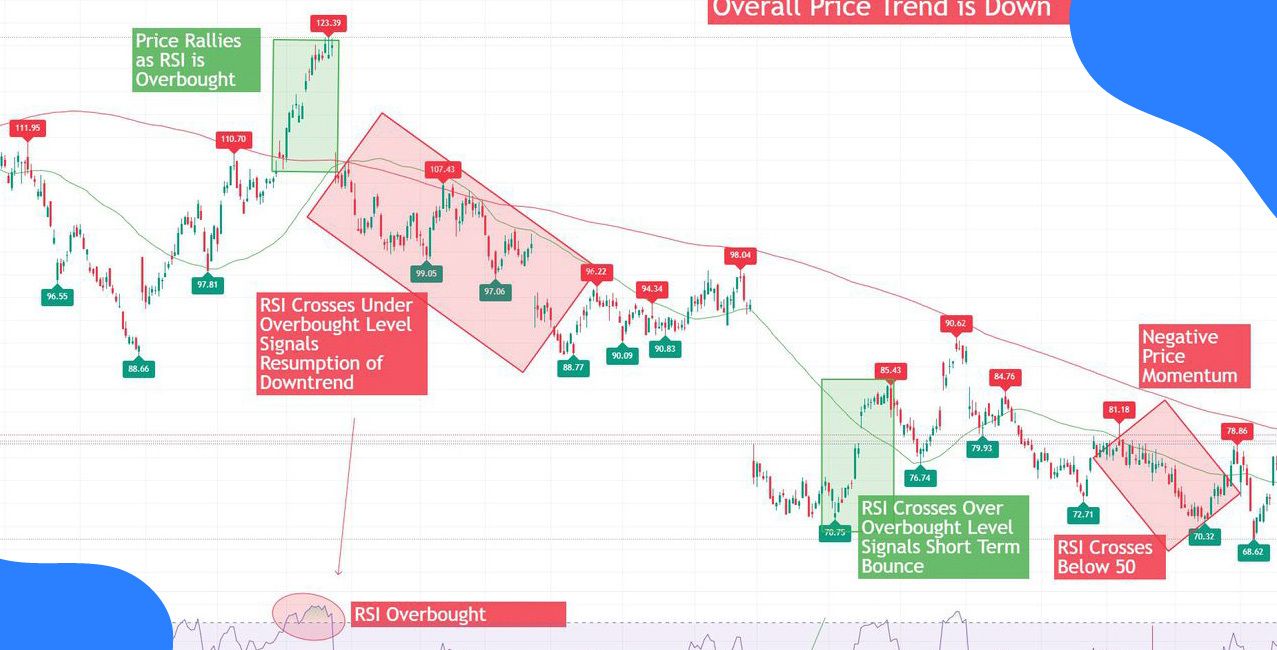RSI shows if a stock price moves too high or too low. Traders use RSI numbers to decide on buying or selling timing.
Example: Rahul watches the Reliance Industries stock using the RSI indicator daily. The stock price rises from ₹2,400 to ₹2,800 quickly. RSI reading climbs from 45 to 85 during this period. When RSI crosses 70, it signals an overbought condition.
Rahul decides to sell his 100 shares immediately. Next week, the stock falls to ₹2,650 per share. His RSI analysis helped him avoid a ₹15,000 loss. When RSI drops below 30, it indicates an oversold condition. Smart traders buy stocks during oversold situations for profits.
RSI Levels and Trading Signals
RSI helps Indian traders make smarter stock market decisions.
1. Understanding RSI Basics and Calculation
RSI stands for Relative Strength Index in trading. It compares recent gains against recent losses mathematically. The formula divides average gains by average losses. RSI calculation uses fourteen days of price data. Higher RSI numbers mean stronger upward price movement.
Example: Priya studies HDFC Bank stock for RSI calculation. She takes fourteen days of closing prices data. Day 1 shows ₹1,500, Day 14 shows ₹1,580. She calculates daily price changes for each day. Average gain becomes ₹8 per day during the period. Average loss equals ₹3 per day same time. The RSI formula gives a 72.7 reading for HDFC stock.
RSI calculation requires consistent data collection and mathematical precision.
2. RSI Overbought and Oversold Signals
An RSI above 70 indicates overbought stock conditions clearly. Overbought means the stock price rose too high, too quickly. An RSI below 30 shows oversold market conditions instead. Oversold means the stock price fell too low too rapidly. These signals help traders time their entries perfectly.
Example: Amit watches Tata Motors stock RSI readings daily. The stock climbs from ₹400 to ₹520 rapidly. RSI jumps from 45 to 78 during the climb. When RSI crosses 70, Amit sells immediately. Stock drops to ₹480 next week exactly. His RSI signal saved ₹40 per share. Later, RSI falls to 25, indicating oversold. Amit buys shares at the ₹380 price level.
Overbought and oversold signals provide clear trading direction.
3. RSI Divergence Patterns and Trend Analysis
RSI divergence occurs when price and RSI move differently. Bullish divergence shows price falling but RSI rising. Bearish divergence shows price rising but RSI falling. These patterns predict trend reversals very accurately. Smart traders watch divergences for early signals.
Example: Kavya notices the ITC stock showing a bearish divergence pattern. Stock price rises from ₹320 to ₹340. But RSI drops from 65 to 58 simultaneously. This divergence warns of a coming price fall. She sells her 200 shares at ₹340. Stock falls to ₹315 within two weeks. Divergence analysis saved her ₹5,000 potential loss.
Divergence patterns offer powerful trend reversal predictions consistently.
4. RSI Time Frames and Period Settings
RSI works effectively together with different time frames. Daily RSI uses 14-day price data typically. Weekly RSI provides a longer-term trend perspective clearly. Shorter periods make RSI more sensitive to changes. Longer periods smooth out daily price fluctuations better.
Example: Deepak uses multiple RSI time frames for analysis. He checks the 5-minute RSI for intraday trading. Daily RSI helps swing trading decisions perfectly. Weekly RSI shows long-term trend direction clearly. Asian Paints shows a daily RSI of 45. But weekly RSI reads 72, indicating strength. He holds shares for a longer period.
Different time frames provide a complete market picture.
5. RSI Trading Strategies and Risk Management
RSI strategies combine with other indicators for accuracy. Support and resistance levels enhance RSI signals significantly. Moving averages confirm RSI trend directions properly. Stop-loss orders protect against wrong RSI signals. Position sizing depends on RSI signal strength.
Example: Ravi develops a complete RSI trading strategy systematically. He buys Maruti Suzuki when RSI hits 30. The stock price stands at ₹8,500 during purchase. He sets a stop-loss at ₹8,200 immediately. Target price becomes ₹9,200 based on analysis. Stock reaches ₹9,150 within three weeks exactly. His RSI strategy generates ₹650 profit per share.
Systematic RSI strategies improve trading success rates consistently.
Conclusion
The RSI indicator proves invaluable for daily stock market trading decisions. Traders rely on this tool to identify overvalued and undervalued stocks effectively. When combined with other technical analysis tools, RSI delivers optimal results for market participants.
Smart traders act quickly on overbought signals by selling their positions, whilst oversold conditions present excellent purchasing opportunities. Divergence patterns offer traders reliable predictions about upcoming trend reversals. Analysing multiple time frames gives traders comprehensive market insights.
Successful traders always pair RSI analysis with sound risk management strategies. Beginners should practise extensively with paper trading before investing actual capital. Indian stock traders who master RSI techniques consistently achieve higher profitability in their trading activities.
The RSI remains an essential component of any serious trader's technical analysis toolkit, providing clear signals that enhance decision-making and improve overall trading performance.
FAQs
Q1: What does an RSI number of 70 mean in trading?
An RSI above 70 means the stock is overbought.
Q2: When should I buy stocks using RSI?
Buy when RSI falls below 30 for the best results.
Q3: How many days does the RSI calculation need?
RSI typically uses 14 days of price data.
Q4: Can RSI work for intraday trading?
Yes, RSI works well for short-term day trading.
Q5: Is RSI accurate for all Indian stocks?
RSI works better with high-volume liquid stocks only.
Other Related Pages | |||





